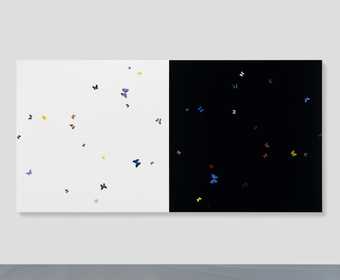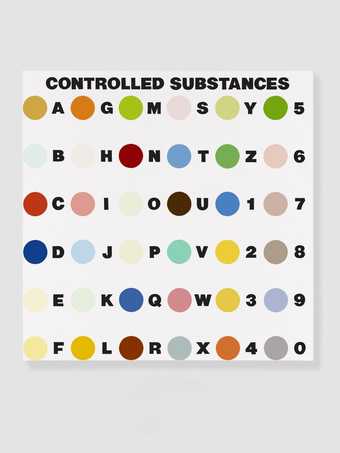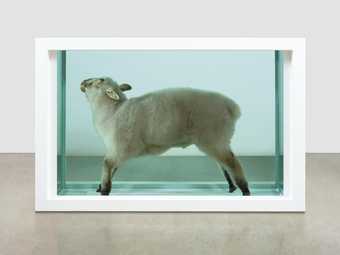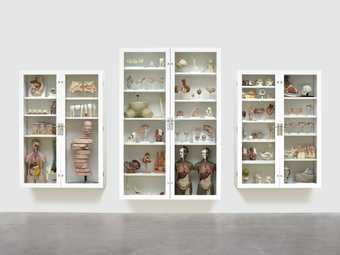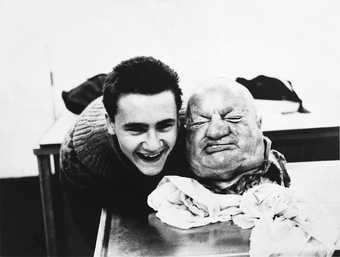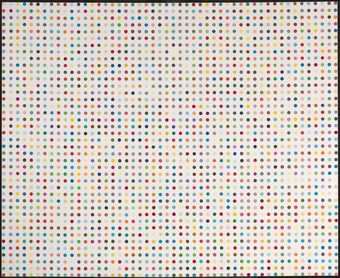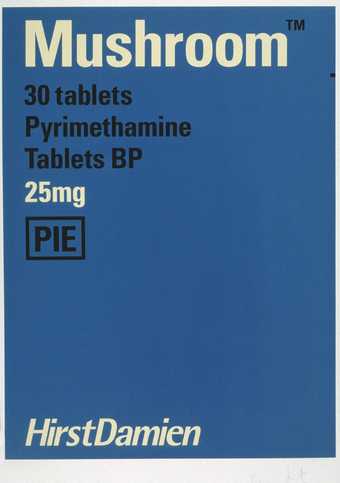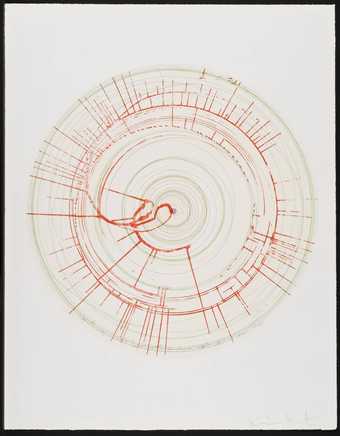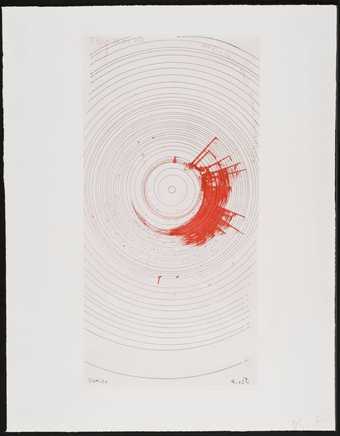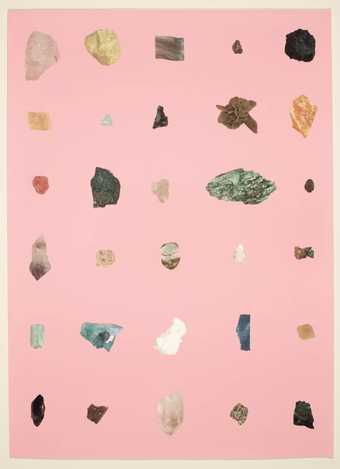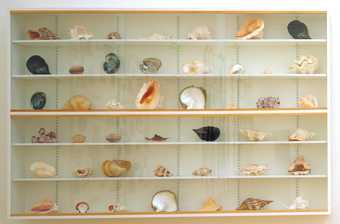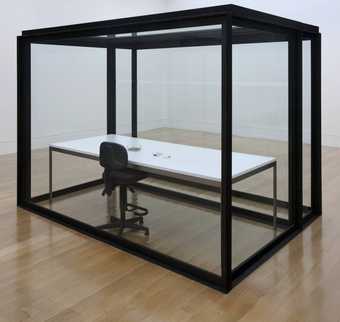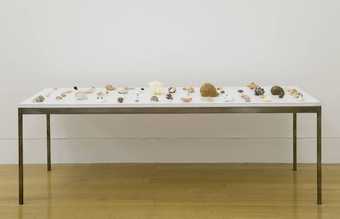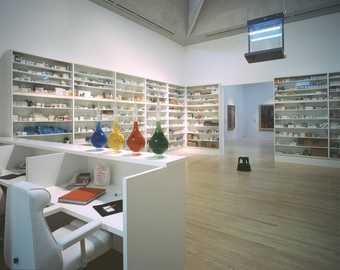
Not on display
- Artist
- Damien Hirst born 1965
- Medium
- Glass, stainless steel, perspex, acrylic paint, cow, calf and formaldehyde solution
- Dimensions
- 2 parts: 2086 × 3225 × 1092 mm, 2086 × 3225 × 1092 mm
2 parts: 1136 × 1689 × 622 mm, 1136 × 1689 × 622 mm
Weight installed: approx. 15,750 kg
Weight of each cow half in transit tank 2940 kg - Collection
- Tate
- Acquisition
- Presented by the artist 2007
- Reference
- T12751
Summary
Mother and Child Divided is a floor-based sculpture comprising four glass-walled tanks, containing the two halves of a cow and calf, each bisected and preserved in formaldehyde solution. The tanks are installed in pairs, the two halves of the calf in front of the two halves of the mother, with sufficient space between each pair that a visitor may walk between them and view the animals’ insides. Thick white frames surround and support the tanks, setting in brilliant relief the transparent turquoise of the formaldehyde solution in which the carcasses are immersed. The sculpture was created for exhibition at the 1993 Venice Biennale and was subsequently the focal point of the 1995 Turner Prize at Tate Britain (then The Tate Gallery), the year that Hirst won the prize. It is now in the collection of the Astrup Fernley Museum of Modern Art, Oslo. Hirst created Tate’s copy for exhibition in the Turner Prize Restrospective at Tate Britain in 2007.
One of a group of works collectively entitled Natural History, Mother and Child Divided follows Hirst’s most famous work, created in 1991 for the British collector Charles Saatchi, a tiger shark floating in a giant formaldehyde-filled tank, entitled The Physical Impossibility of Death in the Mind of Somebody Living (reproduced Damien Hirst, exhibition catalogue, Third International Istanbul Biennale 1992, [pp.9–10]). In the same year the artist filled two sets of shelves with fish in solution in individual Perspex boxes and titled the two separate works Isolated Elements Swimming in the Same Direction for the Purpose of Understanding followed by the bracketed words ‘left’ and ‘right’ indicating the ways the fish are heading (reproduced Damien Hirst, [p.6]). He also made his first works with ungulate carcasses in liquid: Stimulants (and the way they affect the mind and body) (reproduced Damien Hirst, [pp.7–8]), consisting of two cuboid tanks each containing a skinned sheep’s head and Out of Sight. Out of Mind (reproduced Morgan, p.37), two individually encased skinned cows’ heads.
The heavy frames of Hirst’s tanks have been a signature structure since he created his first steel-framed vitrine in 1990, A Thousand Years 1990 (reproduced Hirst pp.28–33), in which a pair of interlinked glass cells hosts a colony of flies living in a rotting cow’s head and dying on an Insect-O-Cutor. Like A Thousand Years, Mother and Child Divided combines the pure clean lines of classic Minimalist sculpture, with the uncomfortably eviscerated flesh of a portrait by the painter Francis Bacon (1909–92). Bacon saw and praised A Thousand Years not long before he died in 1992. Hirst has frequently cited Bacon as an early influence (Damien Hirst and Gordon Burn, On the Way to Work, London 2001, pp.68–9), making a sculptural homage to Bacon’s many triptychs of his lover George Dyer in a work entitled The Tranquillity of Solitude (For George Dyer) 2006, in which skinned sheeps’ carcasses take the place of Dyer, sitting on a toilet or leaning over a basin, each individually immersed in a formaldehyde-filled vitrine.
The heavy industrial aesthetic of the Hirst’s tanks and vitrines references the sculptural forms of such American Minimalists as Donald Judd (1928–94) and Carl André (born 1935). Placing objects in solution in tanks, Hirst follows the precedent of American Pop artist Jeff Koons (born 1955), whose Total Equilibrium Tanks created in 1985 fetishised professional baseballs and art objects at the same time by suspending the balls in solution in glass vitrines on black steel stands (see T06991). Hirst has commented that the vitrines, ‘first came from a fear of everything in life being so fragile’ and wanting ‘to make a sculpture where the fragility was encased. Where it exists in its own space. The sculpture is spatially contained.’ (Quoted in Button, p.114.) The white frames that surround the formaldehyde tanks are particularly dominating visually because of their width, and now function as something of an artist’s logo. Hirst has explained that he is attracted to formaldehyde ‘because it is dangerous and it burns your skin. If you breathe it in it chokes you and it looks like water. I associate it with memory.’ (Hirst, p.298.) He has also commented that he uses it not for its preservative qualities, but ‘to communicate an idea’ (quoted in Adrian Dannatt, ‘Damien Hirst: Life’s like this, then it stops’, Flash Art, no.169, March–April 1993, p.61). Central to this is the futility of preservation in the face of death – that whatever we do to protect bodies against entropy, inevitably, eventually they will disintegrate and die.
In its reference to a mother and child, Mother and Child Divided subverts one of the oldest icons of Western Christian art – the portrait of the Holy Mother and Child traditionally the centrepiece of Catholic devotion. Hirst attended a Catholic school so the iconography is familiar to him, as he has commented: ‘I have a lot of strong memories of religious imagery. We had a big illustrated bible and when I was young I would go straight to the crucifixion or severed head pages.’ (Quoted in Dannatt, p.62.) Instead of the joyful unity of mother and baby, which the traditional image celebrates, Hirst presents a mother and child not only forever separated from one another, but also fatally severed in themselves. The impossibility of achieving or retaining an idealised (lost) unity (often coupled with a fear of fragmentation) is a theme dealt with extensively in psychoanalysis (by Sigmund Freud (1856–1939) in his 1920 essay Beyond the Pleasure Principle, and subsequently by Melanie Klein (1882–1960) and Jacques Lacan (1901–81) in various papers. It is the subject of several works made by Hirst in the early 1990s, with such titles as I want to spend the rest of my life everywhere, with everyone, one to one, always, forever, now 1991 (reproduced Damien Hirst, [pp.1–2]), in which a ping-pong ball floats on a jet of air above a structure made of panes of glass. Love’s Paradox (Surrender or Autonomy, Separateness as a Precondition for Connection) 2007 (reproduced Damien Hirst: Beyond Belief, exhibition catalogue, White Cube, London 2008, pp.43–4), comprising two tanks each containing the severed forequarters of a cow, is a development of this theme.
In the same year that he created Mother and Child Divided Hirst bisected his own work The Acquired Inability to Escape 1991 twice (see T12748), setting the precedent for a series of divided works, reflecting on and emphasising his obsession with the mind-body dualism that was being articulated as a significant debate in art in the early 1990s. For Hirst, the bisecting and skinning of animals is about giving people the possibility to look in a new way. He has explained that cutting up cows and sheep is:
like creating emotions scientifically. What do you do if an animal is symmetrical? You cut it in half, and you can see what’s on the inside and outside simultaneously. It’s beautiful. The only problem is that it’s dead ... In a way, you understand more about living people by dealing with dead people. It’s sad but you feel more ... a viewer should be intrigued. The work should attract you and repel you at the same time ... cows are the most slaughtered animals ever ... I see them as death objects. Walking food ... What’s sad is that if you look at my cows cut up in formaldehyde, they have more personality than any cows walking about in fields.
(Quoted in Morgan, pp.17–18.)
Hirst worked in a mortuary for several months after graduating from Goldsmiths College (BA Fine Art 1985–8), where he discovered that everyday exposure to corpses dulled his sense of the horror of death but did not lessen its mystery. While it revealed the internal structure of once-living beings, it failed to reveal ‘the mystic truths’ American artist Bruce Nauman (born 1941) claimed that ‘true art’ should reveal. Hirst has frequently referred to Nauman’s work The True Artist Helps the World by Revealing Mystic Truths 1967 (Pompidou Centre, Paris), which presents the title words spiralling outwards in neon script on the wall, most recently acknowledging it to be his favourite work of art (Damien Hirst, exhibition catalogue, Museo Archeologico Nazionale, Naples 2004, p.131). Hirst continued his use of animals in tanks as metaphors for religious themes in 1994 with Away from the Flock (AR00499) – a single, whole sheep in formaldehyde-filled tank – and XII Disciples – a series of flayed bovine heads presented in glass tanks (reproduced Hirst pp.CCCXVIII–CCCXXV). He developed his interest in bisection with a cow and bull sliced vertically eight times, mounted in individual tanks, and titled Some Comfort Gained from the Acceptance of the Inherent Lies in Everything 1996 (reproduced Hirst pp.310–13), elaborating that: ‘... [the inherent lies are] that you have to kill things in order to look at them’ (Morgan p.20). Death Explained 2007 (reproduced Damien Hirst: Beyond Belief, pp.108–9), presenting a bisected shark in two separated tanks as in T12751, returns to this subject in the face of a theatrically staged existential despair.
Further reading:
Damien Hirst, I want to spend the rest of my life everywhere, with everyone, one to one, always, forever, now, London 1997, pp.9 and 296, reproduced p.307.
Virginia Button, The Turner Prize, London 1997, pp.112, 114 and 116, reproduced front cover (detail) and p.113.
Stuart Morgan, No Sense of Absolute Corruption, exhibition catalogue, Gagosian Gallery, New York 1996, reproduced pp.39 and 41–3 (detail).
Elizabeth Manchester
April/June 2009
Does this text contain inaccurate information or language that you feel we should improve or change? We would like to hear from you.
Explore
- emotions, concepts and ideas(16,416)
-
- formal qualities(12,454)
-
- found object / readymade(2,631)
- repetition(391)
- symmetry(220)
- vessels and containers(2,157)
-
- tank(3)
- birth to death(1,472)
-
- mortality(49)
- dissection(11)
You might like
-
Damien Hirst Monument to the Living and the Dead
2006 -
Damien Hirst Controlled Substance Key Painting
1994 -
Damien Hirst Away from the Flock
1994 -
Damien Hirst Trinity - Pharmacology, Physiology, Pathology
2000 -
Damien Hirst With Dead Head
1991 -
Damien Hirst Anthraquinone-1-Diazonium Chloride
1994 -
Damien Hirst Mushroom
1999 -
Damien Hirst Steak and Kidney
1999 -
Damien Hirst There’s more to life than making jam and having kids
2002 -
Damien Hirst Oh my God ... and for those really stubborn stains!!!!!??*
2002 -
Damien Hirst Untitled
1992 -
Damien Hirst Forms Without Life
1991 -
Damien Hirst The Acquired Inability to Escape
1991 -
Damien Hirst Life Without You
1991 -
Damien Hirst Pharmacy
1992

